| Hardware World |
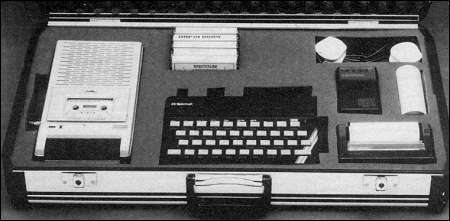
FROM ROTRONICS there is a range of computer cases, suitable for the ZX-81, Spectrum and other computers - Vic-20, Commodore 64 and Oric. The basic case measures 695mm. x 360mm. x 140mm. overall and contains a pre-cut, brushed nylon foam insert in the base to hold the computer, power supply, tape deck, Sinclair Printer, paper and cassettes. The top has a cut-out for the manual and a knife is included to make any further modifications.
Uncut foam bases can also be supplied for users to customise their own cases. The case is lockable and when in use the top is removable to allow the base to be used as a workstation.
As the computer cut-out is designed for the computer alone, peripheral owners are presented with a problem. ZX-81 owners with a RAM pack, or similar, will need to make a cut-out in the top foam to accommodate it. Spectrum owners may also experience problems, not only with devices plugged into the edge connector but to fit them into the case the tape deck needs to be re-positioned to the right of the computer, the printer behind and the power supply to the back left. That will allow two drives to be put alongside the computer; if a suitable lead could be obtained, there is space for another two behind them. Those modifications can be made easily using the knife supplied but planning and care are required. If your computer normally becomes hot in use it may also be necessary to enlarge the ventilation slot.
The front and back faces of the case are made of extruded aluminium and the end faces of black plastic which, while not the strongest materials available, are sufficient for its designed use. Its only disadvantages are the top and bottom panels which appear to be made of laminated pressed cardboard and would be little more than showerproof.
At £36.99 for the case, with choice of insert and extra inserts at £5.95 the case is worth considering.
Available from SMT, Northamptonshire.
THE NEW I/O port from Multitron gives the Spectrum a means of communicating with the outside world. Using the port it could control motors, turn lights on and off or detect when a switch has been closed. It transfers signals to and from the outside in a form the CPU can understand.
For the technically-minded it is an uncased PCB with through connector based on the Intel 8255 AP-5 chip. The chip has three 8-bit ports - A, B and C - and a control register (D), the addresses being 31, 63, 95 and 127 respectively. Each port can be set to either input or output with the upper and lower nibbles of port C capable of being set independently to either. Two more modes of operation are available, which allow strobed I/O with handshaking and strobed bidirectional operation; in both cases the data can be latched. Details are given in the user manual supplied.
Connections to the board are either by a 28-way Spectrum-style edge connector or soldercon pins - breadboard style. The manual gives comprehensive details of how the port works and how to set it up. It also includes two brief programs, one to make the port test itself and one to show binary numbers being output to LEDs.
One thing it does not do is to give simple circuit diagrams to show how to connect a LED or perhaps a relay.
At a very reasonable £13.50 plus 35 pence p&p, including manual, it provides a cheap introduction to control applications.
The board is available from Multitron, Worcs.
AT ONE TIME or another many users, especially ZX-81 owners, must have experienced a computer crash when a nearby mains appliance was turned on or off. The Powercleaner from B & R Electrical should prevent that happening. It works by limiting any surges caused by sudden switching to a peak of 625V, almost instantaneously.
The Powercleaner looks like an ordinary mains plug fitted with a 5amp fuse with an over-large back which contains the electronics. When a spike in the power supply occurs the Powercleaner cuts in to smooth the voltage without interrupting the supply to the computer.
If you are experiencing mains problems, the Powercleaner might be a useful addition. B & R Electrical is at Harlow, Essex.
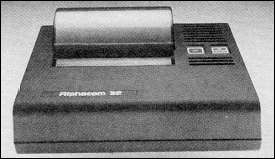
DEAN ELECTRONICS has announced the introduction of a Sinclair-compatible thermal printer, the Alphacom 32. It is manufactured by the American company which produces the Timex-Sinclair 2040 printer - reviewed in the July Sinclair User. The printer is very different from the U.K. Sinclair printer in both external appearance and print quality but is designed to be just as easy to use. It plugs into the rear connector of either a ZX-81 or Spectrum and will accept the standard commands of LPRINT, LLIST and COPY.
That means it can be used in exactly the same manner as the Sinclair, without alteration to existing software. Using 110mm. wide white thermal paper, it produces a very readable output at a speed of roughly two lines per second.
The printer casing is approximately 195 x 140 x 55mm., black-moulded ABS, with a perspex blister on top which holds the paper. Two thick wires emerge from the back, one about 150mm. long to the edge connector which has a ZX-81-size connector to the computer and a through port for RAM packs and the other to the supplied external power supply by way of a male 3.5mm. jack plug.
Inside the printer there is a minimum of electronics, a ROM chip to handle the printer operations, five chips to control the printing mechanism, a handful of discrete components and two PCB-mounted switches to turn the printer on and off and to advance the paper; the use of both switches together performs a self-test function.
The bulk of the space is taken up with a very, solid-looking, rubber-mounted, printer mechanism. The mechanism contains, to one side, a 15V motor which, through a series of nylon gears, turns the rubber platen which feeds the paper through and also moves the printhead.
The printhead is made of a ceramic material into which are inlaid 20 wires. As they are moved across the paper they burn off the top surface of the paper to leave a black ink impression.
Each wire covers two character squares in a zig-zag fashion which shows up the only disadvantage of the printer. When producing a copy this zig-zag is noticeable on any solid blocks of ink.
The printer becomes warm in use but that is not a problem as there are adequate ventilation slots on the top and bottom and a large heatsink inside.
One slight problem, however, is that on a Spectrum the edge connector lead fouls the power lead, making insertion difficult.
Priced at £59.95, including power supply and one roll of paper, with extra rolls of paper at only £1, the printer must be seen as a viable alternative to the Sinclair printer.
The Alphacom 32 is obtainable from Dean Electronics Ltd, Berkshire and branches of W H Smith.
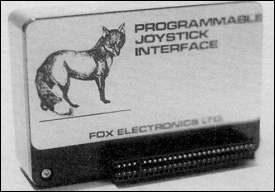
INTRODUCTION of a joystick interface to the Spectrum market passes almost unnoticed these days. To have any hope of selling, the interface must not only be state-of-the-art but also have that something extra. The new programmable joystick interface from Fox Electronics is such a device.
It plugs into the rear connector of the Spectrum and has a through connector for other add-ons. On the right-hand side of the case is a standard Atari-type 9-pin socket for the joystick and one switch.
To use the interface all you have to do is put up the switch, which then displays a menu on the screen. You then have the option of creating a new key set from any of the 40 keys, including the shift keys and ENTER, or selecting, with a single keystroke, one of the 16 sets already created.
Pressing the E key exits to Basic ready to load the game and programs the joystick. If necessary, the key sets can be saved on tape. Leaving the switch down makes the Spectrum ignore the interface.
On putting up the switch the interface pages-out the Spectrum ROM and jumps to the program held in its RAM. The program then transfers itself into the Spectrum RAM, pages the ROM back in, and puts the menu on the screen. On pressing the E key the program transfers itself back into its own RAM, sets up the joystick and clears the Spectrum memory. Any new key sets created are therefore saved in the process.
All that is very clever and provides the easiest interface on the market to use.
At £28.50 the interface is very good value from Fox Electronics Ltd., Hampshire.
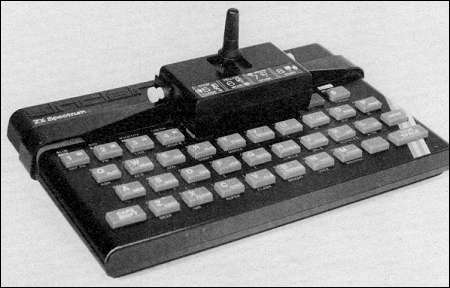
AN ORIGINAL joystick from Grant Designs Ltd, the Spectrum-Stick, clips on to the Spectrum keyboard above the cursor keys 5, 6, 7, and 8 and presses them mechanically in response to the movement of the joystick.
Inside the Spectrum-Stick are two frames which move independently up/down and left/right. To them are attached ramps which push down little feet on to the relevant keys. Despite its ingenious design there are two things to bear in mind. First, the joystick will work only on games which can be configured to use the cursor keys and, second, being made entirely of plastic, it is not so strong as some other joysticks.
Priced at only £9.95, it is far cheaper than anything else on the market and, provided it is used with restraint, will help zap many an alien.
Grant Design, Norfolk.
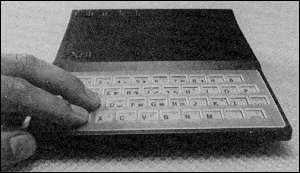
FROM Canada there is yet another ZX-81 keyboard add-on, the Contact Lens from Warren Imports. It is a clear plastic keyboard overlay with wedge-shaped holes which correspond to the key positions.
The idea is that the holes will help position your fingers and enable you to type faster with fewer mistakes. In practice, it ensures that your finger hits the centre of the key, but the holes are on the small side and only your nails can touch the key.
Also the plastic covers the legends around the keys, making them difficult to read.
The Contact Lens may be of some use to young children who have difficulty with the ZX-81 keyboard. To obtain one, write to Warren Import Group, Canada, enclosing $7.95.
A NEW IDEA from Kelwood Computer Cases is the range of Backpacks for the Spectrum and ZX-81. They have a range of facilities from a simple LOAD/SAVE-ON/OFF switching device to one which also includes a sound amplifier and a mains distribution board. Also from Kelwood is the Microstation, a large tray on which can be placed a computer, tape deck and choice of Backpack.
Overall, Backpack One does the job it was designed to do but the job could have been done far better. The LOAD/SAVE switch merely switches the EAR signal line and could induce an earth loop, a common problem on the ZX-81; it is also a mains switch and is therefore not really suitable.
The sound board contains a 1W audio amplifier chip, the LM380N. It also contains, among other things, three Mullard 'liquorice-allsorts' capacitors which although they do the job are about 20 times too big.
The volume control is a 1M logarithmic potentiometer which, apart from being too highly-rated, is wired incorrectly and so the volume needs to be turned up to about two-thirds before anything is heard; it then needs fine adjustment.
Finally the overall soldering can have a number of dry joints, which leads to oxidisation and bad connections.
The Microstation is a metal tray approx 445mm. x 435mm. to which five rubber feet have been riveted.
Backpack One seems overpriced at £27.50, as does the Microstation at £7.50. The full range can be obtained from Kelwood Computer Cases, Rotherham.